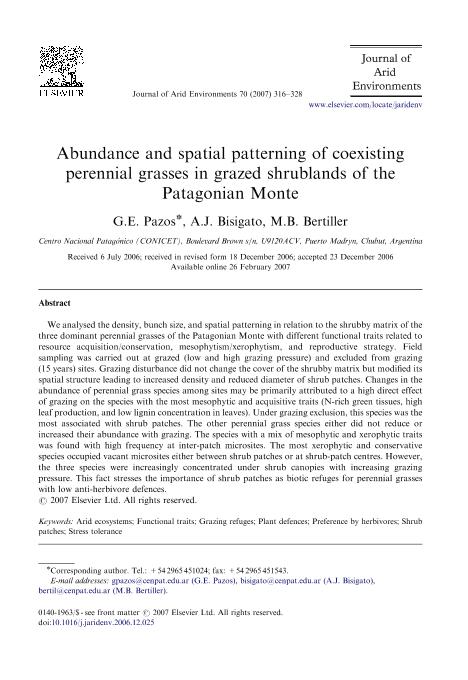Mostrar el registro sencillo del ítem
dc.contributor.author
Pazos, Gustavo Enrique

dc.contributor.author
Bisigato, Alejandro Jorge

dc.contributor.author
Bertiller, Monica Beatriz

dc.date.available
2020-04-16T19:40:13Z
dc.date.issued
2007-07
dc.identifier.citation
Pazos, Gustavo Enrique; Bisigato, Alejandro Jorge; Bertiller, Monica Beatriz; Abundance and spatial patterning of coexisting perennial grasses in grazed shrublands of the Patagonian Monte; Academic Press Ltd - Elsevier Science Ltd; Journal of Arid Environments; 70; 2; 7-2007; 316-328
dc.identifier.issn
0140-1963
dc.identifier.uri
http://hdl.handle.net/11336/102790
dc.description.abstract
We analysed the density, bunch size, and spatial patterning in relation to the shrubby matrix of the three dominant perennial grasses of the Patagonian Monte with different functional traits related to resource acquisition/conservation, mesophytism/xerophytism, and reproductive strategy. Field sampling was carried out at grazed (low and high grazing pressure) and excluded from grazing (15 years) sites. Grazing disturbance did not change the cover of the shrubby matrix but modified its spatial structure leading to increased density and reduced diameter of shrub patches. Changes in the abundance of perennial grass species among sites may be primarily attributed to a high direct effect of grazing on the species with the most mesophytic and acquisitive traits (N-rich green tissues, high leaf production, and low lignin concentration in leaves). Under grazing exclusion, this species was the most associated with shrub patches. The other perennial grass species either did not reduce or increased their abundance with grazing. The species with a mix of mesophytic and xerophytic traits was found with high frequency at inter-patch microsites. The most xerophytic and conservative species occupied vacant microsites either between shrub patches or at shrub-patch centres. However, the three species were increasingly concentrated under shrub canopies with increasing grazing pressure. This fact stresses the importance of shrub patches as biotic refuges for perennial grasses with low anti-herbivore defences.
dc.format
application/pdf
dc.language.iso
eng
dc.publisher
Academic Press Ltd - Elsevier Science Ltd

dc.rights
info:eu-repo/semantics/openAccess
dc.rights.uri
https://creativecommons.org/licenses/by-nc-sa/2.5/ar/
dc.subject
STRESS TOLERANCE
dc.subject
SHRUB PATCHES
dc.subject
ARID ECOSYSTEMS
dc.subject
FUNCTIONAL TRAITS
dc.subject
GRAZING REFUGES
dc.subject
PLANT DEFENCES
dc.subject
PREFERENCE BY HERBIVORES
dc.subject.classification
Otras Ciencias Agrícolas

dc.subject.classification
Otras Ciencias Agrícolas

dc.subject.classification
CIENCIAS AGRÍCOLAS

dc.title
Abundance and spatial patterning of coexisting perennial grasses in grazed shrublands of the Patagonian Monte
dc.type
info:eu-repo/semantics/article
dc.type
info:ar-repo/semantics/artículo
dc.type
info:eu-repo/semantics/publishedVersion
dc.date.updated
2020-04-06T16:06:04Z
dc.journal.volume
70
dc.journal.number
2
dc.journal.pagination
316-328
dc.journal.pais
Países Bajos

dc.journal.ciudad
Amsterdam
dc.description.fil
Fil: Pazos, Gustavo Enrique. Consejo Nacional de Investigaciones Científicas y Técnicas. Centro Nacional Patagónico; Argentina
dc.description.fil
Fil: Bisigato, Alejandro Jorge. Consejo Nacional de Investigaciones Científicas y Técnicas. Centro Nacional Patagónico; Argentina
dc.description.fil
Fil: Bertiller, Monica Beatriz. Consejo Nacional de Investigaciones Científicas y Técnicas. Centro Nacional Patagónico; Argentina
dc.journal.title
Journal of Arid Environments

dc.relation.alternativeid
info:eu-repo/semantics/altIdentifier/doi/http://dx.doi.org/10.1016/j.jaridenv.2006.12.025
dc.relation.alternativeid
info:eu-repo/semantics/altIdentifier/url/https://www.sciencedirect.com/science/article/abs/pii/S0140196307000237
Archivos asociados
